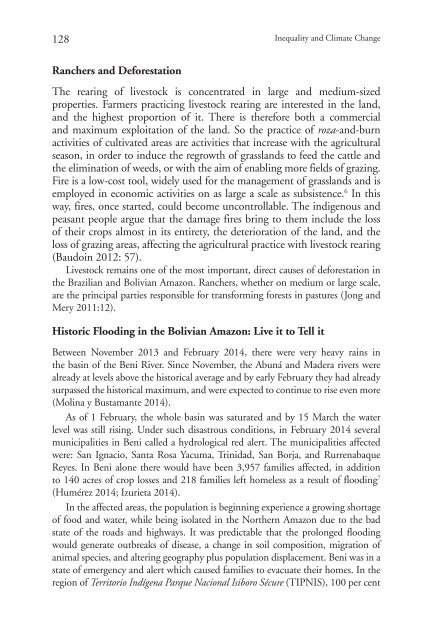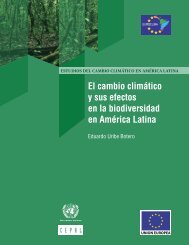Inequality and Climate Change Inégalité et changement climatique
Inequality
Inequality
You also want an ePaper? Increase the reach of your titles
YUMPU automatically turns print PDFs into web optimized ePapers that Google loves.
128<br />
<strong>Inequality</strong> <strong>and</strong> <strong>Climate</strong> <strong>Change</strong><br />
Ranchers <strong>and</strong> Deforestation<br />
The rearing of livestock is concentrated in large <strong>and</strong> medium-sized<br />
properties. Farmers practicing livestock rearing are interested in the l<strong>and</strong>,<br />
<strong>and</strong> the highest proportion of it. There is therefore both a commercial<br />
<strong>and</strong> maximum exploitation of the l<strong>and</strong>. So the practice of roza-<strong>and</strong>-burn<br />
activities of cultivated areas are activities that increase with the agricultural<br />
season, in order to induce the regrowth of grassl<strong>and</strong>s to feed the cattle <strong>and</strong><br />
the elimination of weeds, or with the aim of enabling more fields of grazing.<br />
Fire is a low-cost tool, widely used for the management of grassl<strong>and</strong>s <strong>and</strong> is<br />
employed in economic activities on as large a scale as subsistence. 6 In this<br />
way, fires, once started, could become uncontrollable. The indigenous <strong>and</strong><br />
peasant people argue that the damage fires bring to them include the loss<br />
of their crops almost in its entir<strong>et</strong>y, the d<strong>et</strong>erioration of the l<strong>and</strong>, <strong>and</strong> the<br />
loss of grazing areas, affecting the agricultural practice with livestock rearing<br />
(Baudoin 2012: 57).<br />
Livestock remains one of the most important, direct causes of deforestation in<br />
the Brazilian <strong>and</strong> Bolivian Amazon. Ranchers, wh<strong>et</strong>her on medium or large scale,<br />
are the principal parties responsible for transforming forests in pastures (Jong <strong>and</strong><br />
Mery 2011:12).<br />
Historic Flooding in the Bolivian Amazon: Live it to Tell it<br />
B<strong>et</strong>ween November 2013 <strong>and</strong> February 2014, there were very heavy rains in<br />
the basin of the Beni River. Since November, the Abuná <strong>and</strong> Madera rivers were<br />
already at levels above the historical average <strong>and</strong> by early February they had already<br />
surpassed the historical maximum, <strong>and</strong> were expected to continue to rise even more<br />
(Molina y Bustamante 2014).<br />
As of 1 February, the whole basin was saturated <strong>and</strong> by 15 March the water<br />
level was still rising. Under such disastrous conditions, in February 2014 several<br />
municipalities in Beni called a hydrological red alert. The municipalities affected<br />
were: San Ignacio, Santa Rosa Yacuma, Trinidad, San Borja, <strong>and</strong> Rurrenabaque<br />
Reyes. In Beni alone there would have been 3,957 families affected, in addition<br />
to 140 acres of crop losses <strong>and</strong> 218 families left homeless as a result of flooding 7<br />
(Humérez 2014; Izuri<strong>et</strong>a 2014).<br />
In the affected areas, the population is beginning experience a growing shortage<br />
of food <strong>and</strong> water, while being isolated in the Northern Amazon due to the bad<br />
state of the roads <strong>and</strong> highways. It was predictable that the prolonged flooding<br />
would generate outbreaks of disease, a change in soil composition, migration of<br />
animal species, <strong>and</strong> altering geography plus population displacement. Beni was in a<br />
state of emergency <strong>and</strong> alert which caused families to evacuate their homes. In the<br />
region of Territorio Indígena Parque Nacional Isiboro Sécure (TIPNIS), 100 per cent





